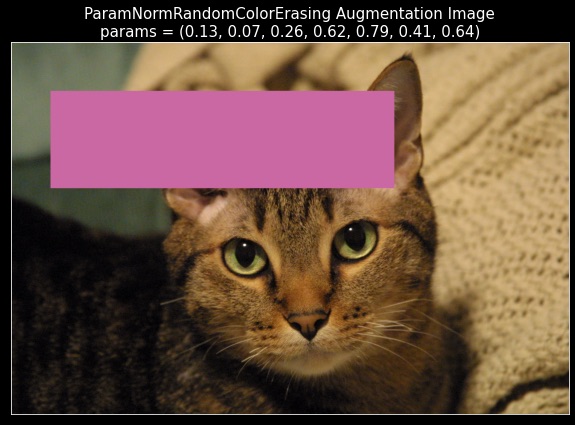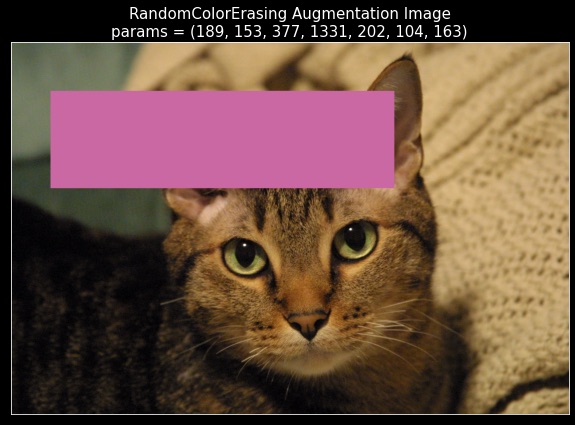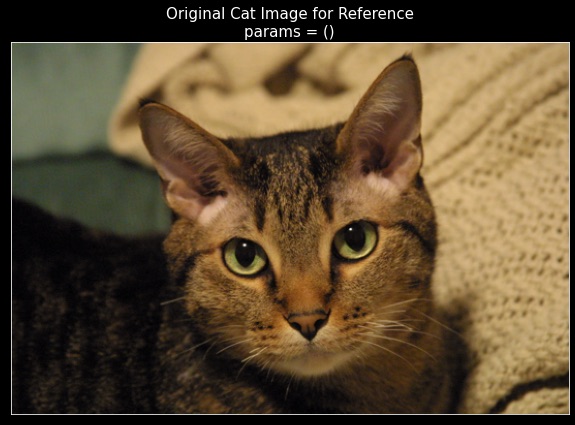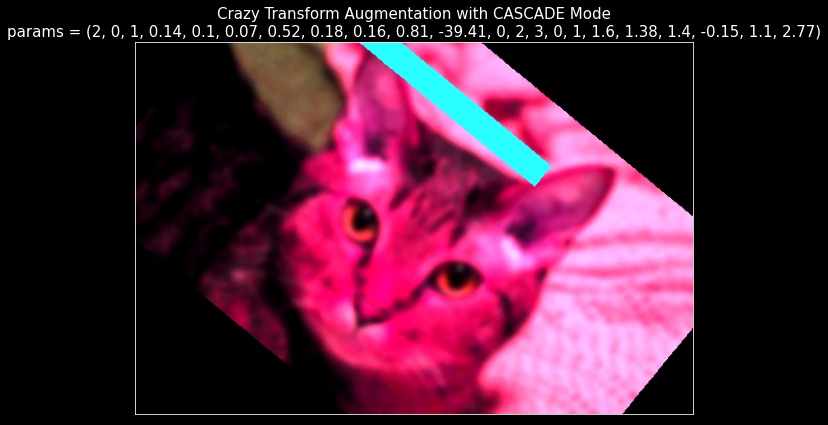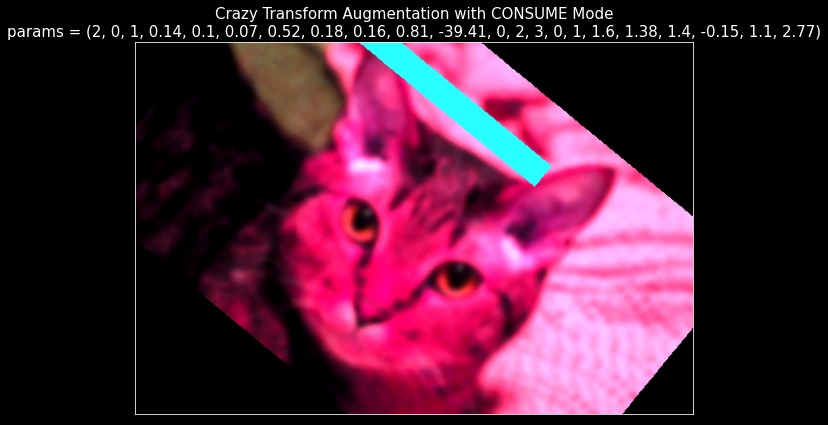Parametrized Transforms in Action#
10 Minute Read
Summary#
In this tutorial, we will take our custom parameterized transforms defined in a previous tutorial, namely
RandomColorErasingandRandomSubsetApply, as well as some of the atomic, composing, and wrapper parameterized transforms provided in the package, and experiment with them! We will combine these transforms in different ways and demonstrate how they can provide a wide range of desired augmentation functionalities.This tutorial should help to further illustrate the power of defining parametrization transforms using the given template; in particular, we will see that defining parameterized transforms with the given template will allow you to achieve any desired augmentation behavior with different componenet transforms in a unified and seamless manner!
Follow the notebook 004-001-Playground.ipynb while going through the details of this tutorial.
Here, we will experiment with the image of Curly, the cat, as shown below–
Exploring Some Transforms from the Package#
This section helps illustrate the power of the two modes of parameterized transforms, CASCADE and CONSUME, and helps in getting acquainted with their performance consistency and consequent augmentation reproducibility.
1. Modes of Operations and Augmentation Reproducibility
To operate any transform in CASCADE mode, one way to achieve this is to define the
tx_modeattribute of the transform to take the valueptc.TransformMode.CASCADEand then call this transform. For example, consider the following chunk of code, which demonstrates different ways to obtain CASCADE and CONSUME mode behaviors of the desired transform.One way is to initialize the transform with the correct mode passed as input for the
tx_modeattribute and the other way is no matter what is the mode of the transform, explicitly calling the desired transform (i.e.,cascade_transformorconsume_transform).Further, the consistency in reproducing augmentations is guaranteed! In particular, as shown in the notebook, the augmented image
aug_cascadematches exactly with the augmented versionsaug_consumeandaug_consume_alternative, as it should!
import parameterized_transforms.transforms as ptx
import parameterized_transforms.core as ptc
tx1 = ptx.RandomRotation(degrees=30, tx_mode=ptc.TransformMode.CASCADE)
aug_cascade, params_cascade = tx1(img=img, params=())
# Since `tx1` is in `CASCADE` mode, `__call__` redirects to `cascade_transform.`
aug_consume, params_consume_remaining = tx1.consume_transform(img=img, params=params_cascade)
# Here, `aug_consume` will exactly match `aug_cascade` from before.
# Even though `tx1` is in `CASCADE` mode, we can request its output as if it were in `CONSUME` mode!
# This is achieved with explicitly calling `consume_transform`.
# And vice versa, explicitly calling `cascade_transform` of a transform in `CONSUME` mode works analogously!
tx2 = ptx.RandomRotation(degrees=30, tx_mode=ptc.TransformMode.CONSUME)
aug_consume_alternative, params_consume_remaining_alternative = \
tx2(img=img, params=params_cascade)
# Since `tx2` is in `CONSUME` mode, `__call__` redirects to `consume_transform`.
# Again, `aug_consume_alternative` will exactly match `aug_cascade`.
2. Default Parameters and Identity Transform Consistency
Further, note that for those transforms where the default parameters preserve the identity of the image, applying the default parameters via the CONSUME mode of the transform actually gives the same image back!
Be careful with which transforms have their default parameters acting as identity transform parameters. This is because for some transforms, like
GrayscaleorCenterCrop, default parameters can lead to loss of information in the image.
However, note that
RandomRotationtransform indeed has its default parameters leading to identity transforms and this is demonstrated in the notebook.
default_params = tx1.get_default_params(img=img)
default_aug, default_remaining_params = tx1.consume_transform(img=img, params=default_params)
# Here, the original image `img` matches exactly with the default augmented `default_aug`.
# And, `default_remaining_params` are empty, as they should be!
We highly encourage the reader to keep in mind these two consistency checks above and try to apply them in the provided notebook as and when appropriate!
Implementing ParamNormRandomColorErasing by Extending RandomColorErasing#
In this section, we will demonstrate the power of the structure used in defining parameterized transforms by showing its capability to easily extend existing transforms. In particular, let us try to implement a transform
ParamNormRandomColorErasing, which performs exactly the same functionality as that provided byRandomColorErasingbut provides access to parameters that are “normalized”.Here, the location and the size of the rectangle to crop from the image are parameterized as a fraction of the size of the image.
Also, the color used to fill the cropped rectangle is represented as float in range
[0, 1].Thus, all the parameters of this transform are in range
[0, 1], making the parameterization “normalized”. We can easily do this by subclassing and extending our already implemented transformRandomColorErasing.
Firstly, observe that we need to update the following two methods from
RandomColorErasing–post_process_paramsandpre_process_params. This is because forpost_process_params, if we subclassRandomColorErasing, we can have access to the standard parameters of the transform viasuperand we would only need to post-process them to obtain the desired normalized parameters. On the other hand, forpre_process_params, we would be having access to normalized parameters and we would only need to define a map to un-normalize them and pass to the pre-processing of thesuper.A subtle point here is that this is it! We ONLY need to update
post_process_paramsandpre_process_params. In particular, our implementation ofget_default_paramsdoes NOT require us to extend it. We encourage the reader to think why this is the case! Hint- when we subclass,selfis now an instance ofParamNormRandomColorErasingand so, inget_default_paramsimplementation ofRandomColorErasing, our extension ofpost_process_paramswill be called!
We implement this extension
ParamNormRandomColorErasingas shown in the notebook.Finally, we can run the same experiment where we obtain parameters from the
ParamNorm-version of the transform, manually un-normalize them, and push through the CONSUME mode of the standard transform. Exactly like the previous section, we see that the augmentations indeed match and we are done!This easy extension of existing transforms is one of the most powerful aspects of our transform design.
Finally, let us visualize the augmentations obtained in the two aforesaid methods along with the original image for reference. Observe that the two augmentations match, as expected!
Arbitrarily Composed and Arbitrarily Nested Transforms#
In this final section, we will see another powerful aspect of our design– we can work with arbitrarily composed and arbitrarily nested transforms using package-provided as well as custom parameterized transform components!
Let us say that we want to research on a very complex and peculiar transform that is meant to have the following functionality–
It has three components, the first being a
RandomSubsetApplycomposing transform with two core transforms– 1.ParamNormRandomColorErasing, and 2.RandomRotationthat rotates the image by an angle (in degrees) sampled from the range[-45, 45].The second component is a random choice; we either want to solarize the image with
RandomSolarizeor we want to transform the image randomly withColorJitter(but NOT BOTH)!And the final component is a sequential application of two different
GaussianBlurtransforms in sequence, achieved using theComposetransform.And finally, we want to apply these three components on an input image in a random order.
This functionality is achieved by the following “crazy” transform–
tx = ptx.RandomOrder(
transforms=[
# The first component is the `RandomSubsetApply` as seen in previous examples!
RandomSubsetApply(
transforms=[
ParamNormRandomColorErasing(
tx_mode=ptc.TransformMode.CASCADE,
default_params_mode=ptc.DefaultParamsMode.RANDOMIZED
),
ptx.RandomRotation(degrees=45)
],
tx_mode=ptc.TransformMode.CASCADE,
),
# The second component is the random choice-- either solarize or apply color-jitter!
ptx.RandomChoice(
transforms=[
ptx.RandomSolarize(threshold=127, p=1.0), # always solarize!
ptx.ColorJitter(
brightness=0.8, contrast=0.8, saturation=0.8, hue=0.2
)
],
tx_mode=ptc.TransformMode.CASCADE,
),
# The third component is an application of two different gaussian blurs!
ptx.Compose(
transforms=[
ptx.GaussianBlur(kernel_size=20, sigma=[0.1, 2.0]),
ptx.GaussianBlur(kernel_size=20, sigma=[0.1, 5.0])
]
)
],
tx_mode=ptc.TransformMode.CASCADE,
default_params_mode=ptc.DefaultParamsMode.RANDOMIZED,
)
Note that this transform contains atomic and composing transforms, some of which are provided by the package while the others being custom-defined. The only thing that we have guaranteed is to follow the transform structure as demonstrated in the previous tutorials.
We now demonstrate that even with this crazy transform, we can indeed achieve the two consistency tests mentioned at the beginning of the tutorial. We will demonstrate that–
we can obtain reproducing augmentations using the CASCADE and CONSUME mode of this crazy transform, and
this crazy transform has well-behaving default parameters, which indeed preserve the identity of the image!
To see this, please run the code in the notebook. This exercise will further bolster your understanding about how the parametrization of augmentation is carried out and why following our structure enables arbitrarily nested and composed transforms that function properly and seamlessly!
From the results, we can see that both the above sanity checks pass! This shows us the real power of the design of the parameterized transforms; we can define arbitrary transformation and they will behave consistently and as expected whether or not the components used in their definition are the transforms provided by the package or the ones custom-written by you!
We conclude this section by visualizing a sample from this crazy augmentation as generated by the CASCADE mode and as reproduced from the parameters by the CONSUME mode. We also show the original cat image for reference.
Be careful that running this transform may take some time in case the image is large.
About the Next Tutorial#
Having seen the capabilities and power of the parameterized transforms and their design, the next tutorial 005-Migrate-To-and-From-torch-in-Three-Easy-Steps will demonstrate how you can port your codebase written in
torch/torchvisionto use our package in3simple steps.Similarly, we will show how to port back a codebase that uses parameterized transforms to make the transforms it with
torch/torchvision-based code.


